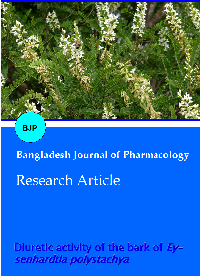Diuretic activity of the bark of Eysenhardtia polystachya
DOI:
https://doi.org/10.3329/bjp.v11i1.24659Keywords:
Diuretic, Eysenhardtia polystachya, FurosemideAbstract
The aim of this study was to evaluate the diuretic activity of Eysenhardtia polystachya bark aqueous extract at different doses in a rat model. Different doses of E. polystachya (125, 250, 500 and 750 mg/kg body weight), furosemide (4 mg/kg) and vehicle were administered per os to female rats (n=6 animals per group). After 6 hours in metabolic cages, the effect on urinary flow, glomerular ?ltration rate and electrolyte balance of sodium and potassium were assessed in all animals. E. polystachya at the doses of 500 and 750 mg/kg induced diuretic activity, since markedly increased (p<0.05) the urinary flow rate, similar to that of furosemide treated group. Only the dose of 750 mg/kg produced an increment in urinary excretion of sodium but not of potassium compared with control group. These findings indicate that E. polystachya bark-induced diuretic activity, providing evidence for its folkloric use.
Downloads
545
338 Read
248
References
Abdala S, Martín-Herrera D, Benjumea D, Gutiérrez, SD. Diuretic activity of some Smilax canariensis fractions. J Ethnopharmacol. 2012; 140: 27781.
Adam Y, Somchit MN, Sulaiman MR, Nasaruddin AA, Zuraini A, Bustamam AA, Zakaria, ZA. Diuretic properties of Orthosiphon staminem Benth. J Ethnopharmacol. 2009; 124: 154-58.
Alvarez L, Rios MY, Esquivel C, Chávez MI, Delgado G, Aguilar MI, Villarreal ML, Navarro V. Cytotoxic isoflavans from Eysenhardtia polystachya. J Nat Prod. 1998; 61: 767-70.
Amuthan A, Chogtu B, Bairy KL, Sudhakar, Prakash M. Evaluation of diuretic activity of Amaranthus spinosus Linn. aqueous extract in Wistar rats. J Ethnopharmacol. 2012; 140: 424-27.
Argueta VA, Cano ALM, Rodarte ME. Atlas de las Plantas de la Medicina Tradicional Mexicana. Tomo II. Mexico City, Mexico, Instituto Nacional Indigenista, 1994.
Bahmani M, Zargaran A, Rafieian-Kopaei M, Saki K. Ethnobotanical study of medicinal plants used in the management of diabetes mellitus in the Urmia, Northwest Iran. Asian Pac J Trop Med. 2014; 7S1: S348-54.
Benjumea D, Abdala S, Hernandez-Luis F, Pérez-Paz P, Martin-Herrera D. Diuretic activity of Artemisia thuscula, an endemic canary species. J Ethnopharmacol. 2005; 100: 205-9.
Gasparotto JA, Gasparotto FM, Boffo MA, Lourenço ELB, Stefanello MÉA, Salvador MJ, da Silva-Santos JE, Andrade MMC, Kassuya CAL. Diuretic and potassium-sparing effect of isoquercitrinan active flavonoid of Tropaeolum majus L. J Ethnopharmacol. 2011; 134: 210-15.
Hilaly JE, Israili ZH, Lyoussi B. Acute and chronic toxicological studies of Ajuga iva in experimental animals. J Ethnopharmacol. 2004; 91: 43-50.
Lahlou S, Tahraoui A, Israili Z, Lyoussi B. Diuretic activity of aqueous extracts of Carum carvi and Tanacetum vulgare in normal rats. J Ethnopharmacol. 2007; 110: 458-63.
Martín-Herrera D, Abdala S, Benjumea D, Pérez-Paz P. Diuretic activity of Withania aristata: An endemic Canary Island species. J Ethnopharmacol. 2007; 113: 487-91.
Mekonnen T, Urga K, Engidawork E. Evaluation of the diuretic and analgesic activities of the rhizomes of Rumex abyssinicus Jacq in mice. J Ethnopharmacol. 2010; 127, 433-39.
Meléndez CME, Berdeja B, Miranda G. Diuretic effect of the aqueous extract of Bidens odorata in the rat. J Ethnopharmacol. 2004; 95: 36366.
Meléndez-Camargo ME, Contreras-León I, Silva-Torres R. Diuretic effect of alkaloids fraction extracted from Selaginella lepidophylla (Hook. et Grev.) Spring. BLACPMA. 2014; 13: 92-99.
Mukinda JT, Eagles PFK. Acute and sub-chronic oral toxicity profiles of the aqueous extract of Polygala fruticosa in female mice and rats. J Ethnopharmacol. 2010; 128: 236-40.
Osswald H, Schnermann J. Methylxanthines and the kidney. Handb Exp Pharmacol. 2011; 200: 391-412.
Perez GRM, García BE. Evaluation of antidiabetic, antioxidant and antiglycating activities of the Eysenhardtia polystachya. Pharmacogn Mag. 2014; 10: S404-18.
Perez GRM, Vargas SR, Perez GS, Zavala SM. Antiurolithiatic activity of Eysenhardtia polystachya aqueous extract on rats. Phytother Res. 1998; 12: 144-45.
Sadki C, Hacht B, Souliman A, Atmani F. Acute diuretic activity of aqueous Erica multi?ora ?owers and Cynodon dactylon rhizomes extracts in rats. J Ethnopharmacol. 2010; 128: 35256.
Saleem H, Ahmad I, Gill MSA. Phytochemical screening and diuretic activity of Euphorbia granulata. Bangladesh J Pharmacol. 2015; 10: 584-87.

Additional Files
Published
How to Cite
Issue
Section
License
Authors who publish with this journal agree to the following terms:
- Authors retain copyright and grant the journal right of first publication with the work simultaneously licensed under a Creative Commons Attribution License that allows others to share the work with an acknowledgement of the work's authorship and initial publication in this journal.
- Authors are able to enter into separate, additional contractual arrangements for the non-exclusive distribution of the journal's published version of the work (e.g., post it to an institutional repository or publish it in a book), with an acknowledgement of its initial publication in this journal.
- Authors are permitted and encouraged to post their work online (e.g., in institutional repositories or on their website) prior to and during the submission process, as it can lead to productive exchanges, as well as earlier and greater citation of published work (See The Effect of Open Access).
